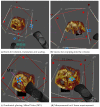A Virtual Reality System for Improved Image-Based Planning of Complex Cardiac Procedures
- PMID: 34460787
- PMCID: PMC8404926
- DOI: 10.3390/jimaging7080151
A Virtual Reality System for Improved Image-Based Planning of Complex Cardiac Procedures
Abstract
The intricate nature of congenital heart disease requires understanding of the complex, patient-specific three-dimensional dynamic anatomy of the heart, from imaging data such as three-dimensional echocardiography for successful outcomes from surgical and interventional procedures. Conventional clinical systems use flat screens, and therefore, display remains two-dimensional, which undermines the full understanding of the three-dimensional dynamic data. Additionally, the control of three-dimensional visualisation with two-dimensional tools is often difficult, so used only by imaging specialists. In this paper, we describe a virtual reality system for immersive surgery planning using dynamic three-dimensional echocardiography, which enables fast prototyping for visualisation such as volume rendering, multiplanar reformatting, flow visualisation and advanced interaction such as three-dimensional cropping, windowing, measurement, haptic feedback, automatic image orientation and multiuser interactions. The available features were evaluated by imaging and nonimaging clinicians, showing that the virtual reality system can help improve the understanding and communication of three-dimensional echocardiography imaging and potentially benefit congenital heart disease treatment.
Keywords: echocardiography; pre-operative imaging; virtual reality.
Conflict of interest statement
The authors declare no conflict of interest. The funders had no role in the design of the study; in the collection, analyses, or interpretation of data; in the writing of the manuscript; nor in the decision to publish the results.
Figures






References
-
- Valverde I., Gomez-Ciriza G., Hussain T., Suarez-Mejias C., Velasco-Forte M.N., Byrne N., Ordonez A., Gonzalez-Calle A., Anderson D., Hazekamp M.G., et al. Three-dimensional printed models for surgical planning of complex congenital heart defects: An international multicentre study. Eur. J. Cardio Thorac. Surg. 2017;52:1139–1148. doi: 10.1093/ejcts/ezx208. - DOI - PubMed
-
- Falah J., Khan S., Alfalah T., Alfalah S.F.M., Chan W., Harrison D.K., Charissis V. Virtual Reality Medical Training System for Anatomy Education. IEEE; London, UK: 2014. pp. 752–758.
Grants and funding
LinkOut - more resources
Full Text Sources
Other Literature Sources

